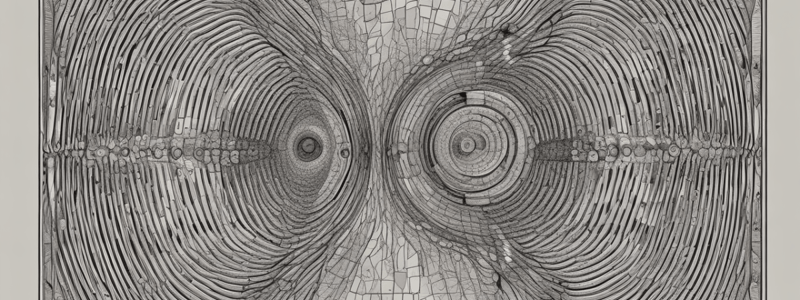Podcast
Questions and Answers
Which condition is a common cause of transient monocular visual loss?
Which condition is a common cause of transient monocular visual loss?
- Cerebral hypoperfusion
- Retinal circulation emboli (correct)
- Occipital lobe stroke
- Pituitary apoplexy
Which of the following is NOT a cause of sudden binocular visual loss without progression?
Which of the following is NOT a cause of sudden binocular visual loss without progression?
- Anterior ischemic optic neuropathy (correct)
- Head trauma
- Occipital lobe stroke
- Pituitary apoplexy
What is a potential cause of progressive visual loss related to visual pathway inflammation?
What is a potential cause of progressive visual loss related to visual pathway inflammation?
- Glaucoma
- Retinal detachment
- Vitreous hemorrhage
- Sarcoidosis (correct)
Which of the following could result from optic disc drusen?
Which of the following could result from optic disc drusen?
Which condition is associated with transient visual obscurations?
Which condition is associated with transient visual obscurations?
Which of the following is a common cause of sudden monocular visual loss without progression?
Which of the following is a common cause of sudden monocular visual loss without progression?
What type of visual loss is typically associated with hereditary optic neuropathies?
What type of visual loss is typically associated with hereditary optic neuropathies?
Which of the following is a characteristic feature of toxic optic neuropathies?
Which of the following is a characteristic feature of toxic optic neuropathies?
What is the disc color characteristic of papilledema?
What is the disc color characteristic of papilledema?
Which feature distinguishes pseudopapilledema from papilledema regarding disc margins?
Which feature distinguishes pseudopapilledema from papilledema regarding disc margins?
How do the vessels appear in papilledema?
How do the vessels appear in papilledema?
What is a notable finding in the nerve fiber layer of papilledema?
What is a notable finding in the nerve fiber layer of papilledema?
Which type of hemorrhage is associated with papilledema?
Which type of hemorrhage is associated with papilledema?
What distinguishes the vessels in pseudopapilledema?
What distinguishes the vessels in pseudopapilledema?
What visual abnormality is characterized by the best detection using automated static perimetry?
What visual abnormality is characterized by the best detection using automated static perimetry?
Which tumor is most commonly associated with rapidly progressive bilateral visual loss?
Which tumor is most commonly associated with rapidly progressive bilateral visual loss?
What is a common symptom associated with CAR (Cancer-Associated Retinopathy)?
What is a common symptom associated with CAR (Cancer-Associated Retinopathy)?
Consider the visual field testing method: which one can demonstrate nonphysiological visual field constriction?
Consider the visual field testing method: which one can demonstrate nonphysiological visual field constriction?
Which assessment is unreliable for diagnosing nonorganic visual loss when patients defocus their vision?
Which assessment is unreliable for diagnosing nonorganic visual loss when patients defocus their vision?
What is a common finding in patients with slow progressive visual loss due to radiation?
What is a common finding in patients with slow progressive visual loss due to radiation?
What indication predicts a better prognosis for nonorganic visual disturbances?
What indication predicts a better prognosis for nonorganic visual disturbances?
Which type of visual disturbance cannot be produced by organic disease?
Which type of visual disturbance cannot be produced by organic disease?
Which of the following visual symptoms is NOT commonly linked to radiation-induced visual loss?
Which of the following visual symptoms is NOT commonly linked to radiation-induced visual loss?
What visual finding would be expected in patients with nonorganic visual disturbances during confrontation testing?
What visual finding would be expected in patients with nonorganic visual disturbances during confrontation testing?
Study Notes
Transient Visual Loss Causes
- Transient Monocular Visual Loss: Caused by retinal circulation emboli, migraines, hypoperfusion, ocular issues, vasculitis (e.g., giant cell arteritis), and other factors like Uhthoff phenomenon and nonorganic loss.
- Transient Binocular Visual Loss: Associated with migraines, cerebral hypoperfusion due to thromboembolism or systemic hypotension, seizures, head trauma, and optic disc edema.
Sudden Visual Loss Causes
- Sudden Monocular Visual Loss Without Progression: Results from central/branch retinal artery occlusion, anterior/posterior ischemic optic neuropathy, retinal vein occlusion, traumatic optic neuropathy, retinal detachment, vitreous hemorrhage, or nonorganic visual loss.
- Sudden Binocular Visual Loss Without Progression: Related to occipital lobe strokes, bilateral ischemic optic neuropathies, pituitary apoplexy, head trauma, and functional loss.
Progressive Visual Loss Factors
- Causes of Progressive Visual Loss: Involves inflammation/compression of the anterior visual pathway, hereditary optic neuropathies, optic disc drusen, glaucoma, chronic papilledema, and radiation damage.
- Symptoms: Central or cecocentral scotomas, temporal pallor and cupping of optic discs, color vision abnormalities, and potential visual field defects.
Nonorganic Visual Disturbances
- Manifestations Include: Loss of visual acuity or field, color perception issues, diplopia, night blindness, and voluntary nystagmus.
- Evaluation Techniques: Confrontation or tangent screen testing at various distances to detect nonorganic constriction; automated static perimetry for cloverleaf constriction; kinetic perimetry for spiraling and inversion of isopters.
Prognosis of Nonorganic Visual Disturbance
- Recovery Rate: About 50% of patients improve with time and reassurance.
- Prognostic Factors: Better prognosis associated with younger age and anxiety; older patients have a worse prognosis.
Papilledema vs. Pseudopapilledema
- Differentiation Features:
- Papilledema: Hyperemic disc color, indistinct margins, normal vessel distribution, dull nerve fiber layer due to edema, splinter hemorrhages.
- Pseudopapilledema: Pink/yellowish pink disc color, distinct margins, anomalous vessel patterns, glistening nerve fiber layer without edema, subretinal/retinal/vitreous hemorrhages.
Other Causes of Visual Loss
- Leber Hereditary Optic Neuropathy (LHON): Often leads to simultaneous bilateral visual loss with mild disc edema.
- Additional Factors: Anemia, hyperviscosity, pickwickian syndrome, hypotension, and significant blood loss can cause bilateral optic disc edema, with the clinical context providing diagnostic clues.
Studying That Suits You
Use AI to generate personalized quizzes and flashcards to suit your learning preferences.
Description
Test your knowledge on the afferent visual system, specifically focusing on the causes of transient monocular and binocular visual loss. This quiz covers essential topics such as retinal circulation emboli, migraine, and vasculitis. Challenge yourself with key concepts from Chapter 16 of Neuro-Ophthalmology.




